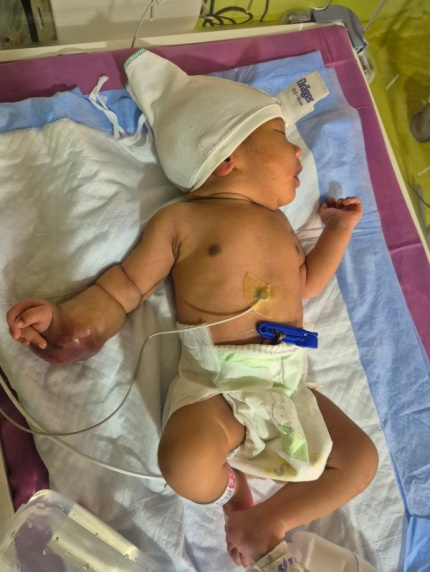Limb Salvage in Infantile Fibrosarcoma of the Upper Limb
- Hemalatha S N
- Feb 22
- 2 min read
Updated: Mar 3
In pediatric oncology, the early diagnosis and timely intervention of tumors are crucial for improving patient outcomes. This blog post discusses a complex case involving a neonate diagnosed with infantile fibrosarcoma, a rare soft tissue tumor, highlighting the collaborative efforts of a multidisciplinary team in achieving limb salvage and optimal patient care.
Initial Presentation And Diagnosis
The infant presented with a noticeable swelling over the right forearm and wrist shortly after birth. Concerned about this anomaly, the parents sought medical attention. By Day 3, an MRI scan revealed a lobulated tumor affecting the flexor compartment and ulnar neurovascular structures. The imaging findings raised significant concerns, prompting an immediate biopsy on Day 4. Histopathological examination confirmed the diagnosis of infantile fibrosarcoma, with NTRK positivity identified as a key marker for targeted therapy.
Progression And Intervention
The case was referred to our institution on Day 28 (December 31, 2024) due to significant tumor growth. At this point, the tumor appeared ulcerative and lobulated, extensively affecting the right forearm and wrist while sparing the hand and fingers. A repeat MRI was performed to assess the extent of progression and neurovascular status.
On January 2, 2025, a Multidisciplinary Team (MDT) discussion took place, involving expert surgeons and oncologists including Dr. Ajay, Dr. Pramod S Chinder, Dr. Indushekar, Dr. Prashanth, Dr. Intezar, Dr. Keerthi, Dr. Satish, and Dr. Raghunath. After thorough deliberation, the team came up with a strategic plan focused on limb salvage
Surgical and Medical Management
January 6, 2025 – Embolization:
Dr. Indushekar and his team performed an embolization procedure to minimize vascularity and reduce intraoperative bleeding risk.
January 7, 2025 – Wide Local Excision and Neurovascular Dissection:
Led by Dr. Pramod S Chinder and his team, a wide local excision of the tumor was carried out along with meticulous neurovascular dissection to preserve essential structures.
January 8, 2025 – Transfer of Superficial Branch of Radial Nerve Graft to Ulnar Nerve:
To ensure proper wound coverage and functional restoration, Dr. Prashanth’s team performed an Anterolateral thigh (ALT) free flap procedure.
Postoperative Care and Challenges
- January 16, 2025: Targeted therapy with Entrectinib was initiated due to NTRK positivity.
- January 15-23, 2025: The patient underwent repeat dressing changes, wound washings, and re-suturing.
- January 20, 2025: Entrectinib was discontinued due to delayed wound healing; therapy strategies were reassessed.
- January 25, 2025: MatriDerm was applied for wound coverage to promote optimal healing.

Outcome and Discharge
With diligent postoperative management, the patient showed remarkable recovery. By January 27, 2025, the infant was deemed fit for discharge.

Conclusion
This case exemplifies the power of early intervention, multidisciplinary collaboration, and advanced surgical techniques in managing rare pediatric malignancies like infantile fibrosarcoma. The integration of targeted therapy and surgical precision played a pivotal role in achieving limb salvage while emphasizing comprehensive patient-centric care.
With continued monitoring and rehabilitation efforts in place, the child now has a promising future—a testament to modern medicine's success in overcoming complex oncological challenges.





















Comments